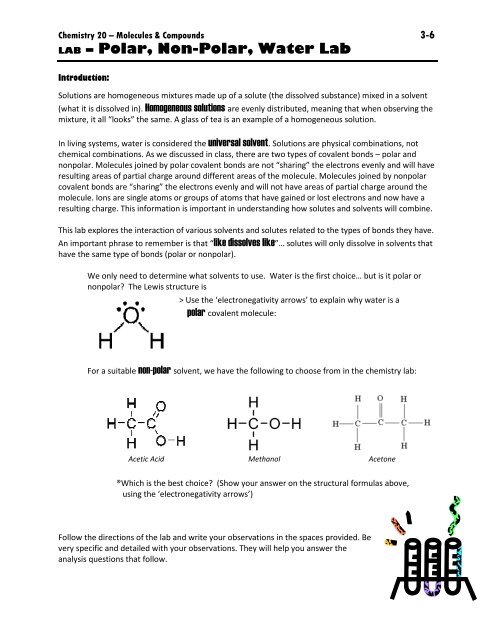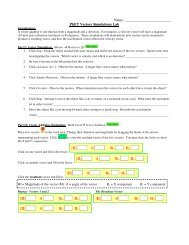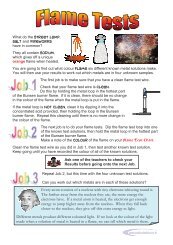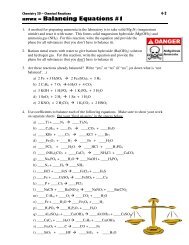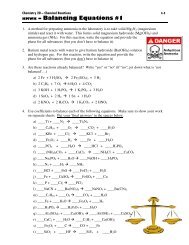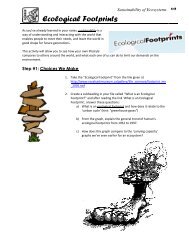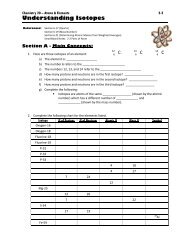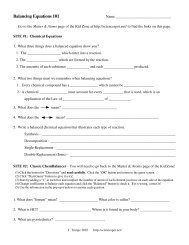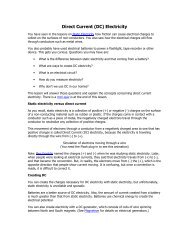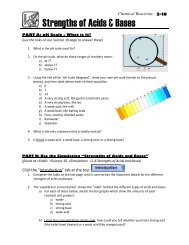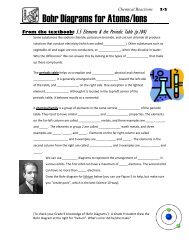You also want an ePaper? Increase the reach of your titles
YUMPU automatically turns print PDFs into web optimized ePapers that Google loves.
Chemistry 20 <strong>–</strong> Molecules & Compounds 3-6<br />
<strong>LAB</strong> <strong>–</strong> <strong>Polar</strong>, <strong>Non</strong>-<strong>Polar</strong>, <strong>Water</strong> <strong>Lab</strong><br />
Introduction:<br />
Solutions are homogeneous mixtures made up of a solute (the dissolved substance) mixed in a solvent<br />
(what it is dissolved in). Homogeneous solutions are evenly distributed, meaning that when observing the<br />
mixture, it all “looks” the same. A glass of tea is an example of a homogeneous solution.<br />
In living systems, water is considered the universal solvent. Solutions are physical combinations, not<br />
chemical combinations. As we discussed in class, there are two types of covalent bonds <strong>–</strong> polar and<br />
nonpolar. Molecules joined by polar covalent bonds are not “sharing” the electrons evenly and will have<br />
resulting areas of partial charge around different areas of the molecule. Molecules joined by nonpolar<br />
covalent bonds are “sharing” the electrons evenly and will not have areas of partial charge around the<br />
molecule. Ions are single atoms or groups of atoms that have gained or lost electrons and now have a<br />
resulting charge. This information is important in understanding how solutes and solvents will combine.<br />
This lab explores the interaction of various solvents and solutes related to the types of bonds they have.<br />
An important phrase to remember is that “like dissolves like”… solutes will only dissolve in solvents that<br />
have the same type of bonds (polar or nonpolar).<br />
We only need to determine what solvents to use. <strong>Water</strong> is the first choice… but is it polar or<br />
nonpolar? The Lewis structure is<br />
> Use the ‘electronegativity arrows’ to explain why water is a<br />
polar covalent molecule:<br />
For a suitable non-polar solvent, we have the following to choose from in the chemistry lab:<br />
Acetic Acid Methanol Acetone<br />
®Which is the best choice? (Show your answer on the structural formulas above,<br />
using the ‘electronegativity arrows’)<br />
Follow the directions of the lab and write your observations in the spaces provided. Be<br />
very specific and detailed with your observations. They will help you answer the<br />
analysis questions that follow.
Part A: What type of bonds are in each solute?<br />
Materials:<br />
5 test tubes <strong>–</strong> labeled #1 through #5<br />
<br />
<br />
<br />
Copper(II) chloride<br />
Iodine (poisonous and can cause burns)<br />
<strong>Water</strong><br />
<br />
<br />
<br />
<br />
<br />
Substance X (the nonpolar solvent)<br />
Spatula<br />
Stoppers<br />
Graduated cylinder<br />
Marker-and-masking-tape<br />
Procedure:<br />
1. In test tube #1 <strong>–</strong> Using a spatula, add a FEW crystals of copper(II) chloride to 3 mL of water in a<br />
test tube. Stopper the tube and shake vigorously. Does the copper(II) chloride dissolve in water?<br />
Explain what you see.<br />
2. In test tube #2 <strong>–</strong> Add a few crystals of iodine with a spatula to 3 mL of water in a second test<br />
tube. Be careful with the iodine! Stopper the test tube and shake it up. Does the iodine readily<br />
dissolve in the water? Explain what you see.<br />
3. In test tube #3 <strong>–</strong> Add a few crystals of copper(II) chloride to 3 mL of “Substance X”. Stopper and<br />
shake well. Does the copper(II) chloride dissolve in substance X? Explain what you see.<br />
4. In test tube #4 <strong>–</strong> Add a few crystals of iodine to 3 mL of substance X. Stopper and shake well.<br />
Does the iodine dissolve well in the substance? Explain what you see.<br />
5. In test tube #5 <strong>–</strong> Add 3 mL of substance X. Then add the iodine water solution you prepared in<br />
test tube #2. Pour the contents of test tube #2 into test tube #5. Stopper and shake well.<br />
Describe the results.<br />
6. Pour the contents of test tube #1 into test tube #4. Stopper and shake well. Describe your<br />
results.<br />
7. Now add 10 drops of detergent to test tube #4 which contains the combination of test tubes #1<br />
and #4. Stopper and shake well. Do the two liquids separate as before? Describe what you see.
Analysis Questions<br />
Study your data that you have recorded concerning the solvents and solutes that you combined<br />
above. Think about the nature of the bonds as you answer the following questions.<br />
1. Define the bolded terms from the introduction.<br />
2. Which solute, [copper(II) chloride or iodine] can dissolve in water, and why?<br />
3. Which solute, [copper(II) chloride or iodine] can dissolve in substance X, and why?<br />
4. Which of the solutes used in this lab is nonpolar, and WHY?<br />
5. Which of the solvents used in this lab is nonpolar, and WHY?<br />
6. What did you do in step #5, and why did you get the results that you observed<br />
in step #5?<br />
7. What did you do in step #6, and why did you get the results that you observed in<br />
step #6?<br />
8. What did you do in step #7, and why did you get the results that you observed<br />
in step #7?<br />
9. [On a separate paper] What is one application where ‘molecular geometry’<br />
(or shapes-of-molecules) is important to real-life? MAKE SURE each group member<br />
chooses a different topic AND explain in a well-described paragraph of 45 words,<br />
minimum. (links provided)
Part B: Pennies<br />
Using the pennies and dropper provided <strong>–</strong> each team member should perform and<br />
complete this activity. Compete with each other for “who can place the most drops of<br />
water on the penny WITHOUT spilling off the penny” and “who can place the most<br />
drops of alcohol on the penny WITHOUT spilling off the penny.” Record your results in the table below.<br />
Name of Team Member<br />
# of <strong>Water</strong> Drops<br />
on the penny<br />
# of Alcohol Drops<br />
on the penny<br />
Analysis Questions:<br />
1. Explain how ‘hydrogen bonding’ relates to the surface tension of water. (link provided)<br />
2. From your group’s findings, does an alcohol have more or less ‘hydrogen bonding’ than water?<br />
How can you tell?<br />
Part C: Pepper<br />
Shake some pepper on top of water in a small petri dish. Add a drop of detergent to the petri dish. What<br />
happens to the water and pepper when you added the drop of detergent?<br />
Analysis Questions:<br />
1. Based on your observations, hypothesize (with reasons) whether the pepper is polar or<br />
nonpolar.<br />
2. Using ‘hydrogen bonds’ in your answer, explain why the pepper did-whatit-did<br />
when the detergent was added. (link provided)


